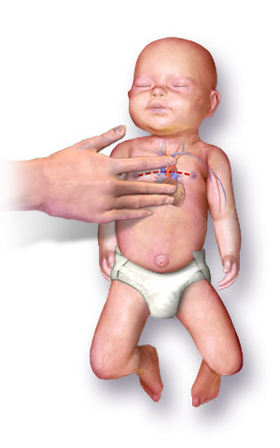| Neonatal resuscitation | |
|---|---|
 | |
| Specialty | neonatology |
| Frequency | 10% of newborns who do not readily begin breathing |
Neonatal resuscitation, also known as newborn resuscitation, is an emergency procedure focused on supporting approximately 10% of newborn children who do not readily begin breathing, putting them at risk of irreversible organ injury and death.[1] Many of the infants who require this support to start breathing well on their own after assistance. Through positive airway pressure, and in severe cases chest compressions, medical personnel certified in neonatal resuscitation can often stimulate neonates to begin breathing on their own, with attendant normalization of heart rate.[2]
Face masks that cover the infant's mouth and nose are often used in the resuscitation procedures. Nasal prongs/tubes/masks and laryngeal mask airway devices are also sometimes used.[3]
- ^ "Neonatal Resuscitation - Pediatrics". Merck Manuals Professional Edition. Retrieved 2019-11-13.
- ^ Johnson, Peter A.; Schmölzer, Georg M. (23 February 2020). "Heart Rate Assessment during Neonatal Resuscitation". Healthcare. 8 (1): 43. doi:10.3390/healthcare8010043. PMC 7151423. PMID 32102255.
- ^ Ni Chathasaigh, Caitriona M; Davis, Peter G; O'Donnell, Colm PF; McCarthy, Lisa K (2023-10-03). Cochrane Neonatal Group (ed.). "Nasal interfaces for neonatal resuscitation". Cochrane Database of Systematic Reviews. 2023 (10). doi:10.1002/14651858.CD009102.pub2. PMC 10546484. PMID 37787113.